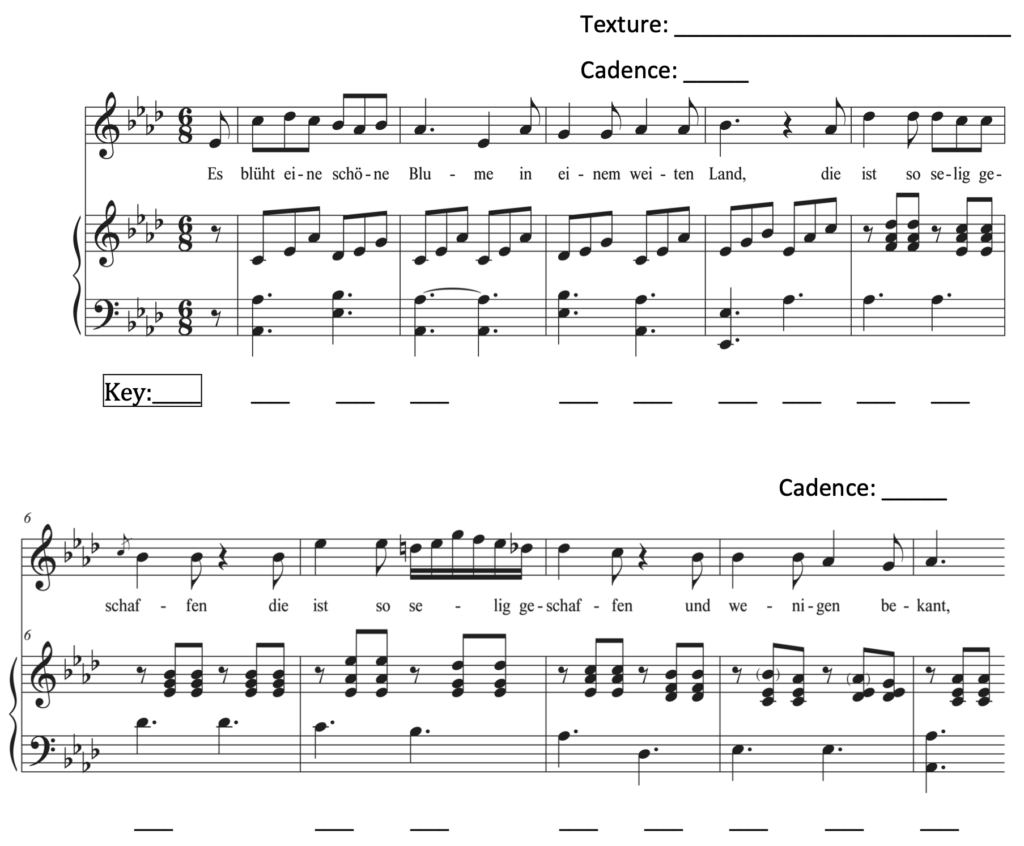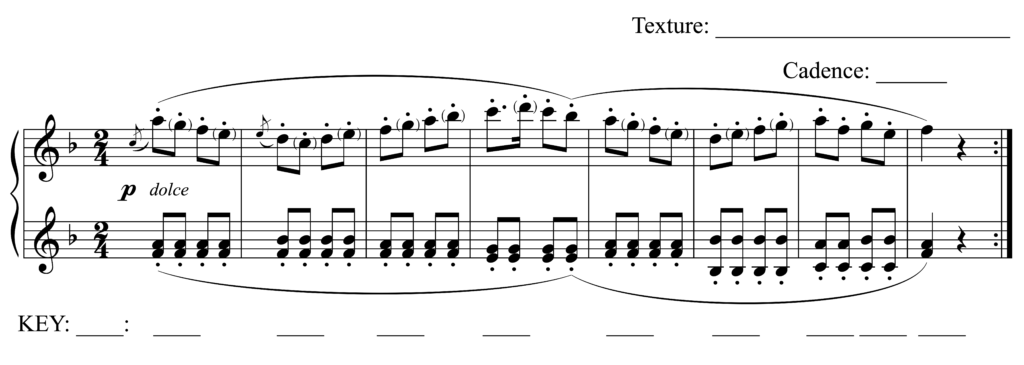Main Body
26 Chords in second inversion
Learning goals for Chapter 26
In this chapter, we will learn:
- The primary ways chords are used in musical contexts
- How to identify the function of , aurally and in scores
- How to voice and connect second-inversion triads in four-part textures
Second-inversion chords
Similar to chords, or are often used to create more interesting chord progressions and bass lines. There are three primary types of six-four chords: the , the , and the .
The primary characteristic of the , illustrated in Example 26‑1, involves the bass note of the six-four chord, which is prepared and resolved by step in the same direction, either up (as in this example) or down.
Unlike the passing six-four, which can be any diatonic chord (flexible harmonic function) within a key, the expresses and almost always immediately precedes a root-position V or V7 chord. Thus, the bass note of the cadential six-four is always scale degree ![]() (“sol”). In four-voice writing, the bass note and one other voice stay on scale degree
(“sol”). In four-voice writing, the bass note and one other voice stay on scale degree ![]() when connecting to the V chord, creating motion with two of the upper voices that move down by step. Example 26‑2 shows an example of the cadential six-four chord used in E
when connecting to the V chord, creating motion with two of the upper voices that move down by step. Example 26‑2 shows an example of the cadential six-four chord used in E![]() major.
major.
The chord is an embellishing chord, appearing with a static bass line. The bass line acts as a pedal tone (hence its name). Some textbooks call this chord a neighboring six-four because its upper voices act as upper neighbor notes to the chord on either side of the six-four. Example 26‑3 shows a pedal six-four in the key of F major, in this case a second-inversion B![]() major (subdominant) triad, which embellishes the E
major (subdominant) triad, which embellishes the E![]() major (tonic) chord before and after it, sharing the same bass note.
major (tonic) chord before and after it, sharing the same bass note.
Occasionally, a six-four chord will result from an arpeggiated bass line or texture, but otherwise most six-four chords will be one of the three types shown above.
Video: T43 Intro to six-four chords (6:25)
This video briefly summarizes the properties of all three triad positions (, , and ) and explains in further detail the three uses of second inversion triads (aka “six-four” chords): the , , and chords.
Seventh chords in second inversion, four-three (![]() ) chords, do not have the same versatility as six-four chords, but occasionally they do function in a pedal or passing capacity. The functions similarly to the passing six-four. Compare the passing four-three in Example 26‑4 with the passing six-four in Example 26‑1 above.
) chords, do not have the same versatility as six-four chords, but occasionally they do function in a pedal or passing capacity. The functions similarly to the passing six-four. Compare the passing four-three in Example 26‑4 with the passing six-four in Example 26‑1 above.
Six-four chords in context
Example 26‑5 features a compelling use of the passing six-four and draws upon a repeating chord progression. Notice that the bass line features a stepwise descent. When the bass line features scale degree ![]() (E, or “re”), it creates stepwise motion as the progression repeats, connecting from “mi” (F
(E, or “re”), it creates stepwise motion as the progression repeats, connecting from “mi” (F![]() ) to “do” (D).
) to “do” (D).
Example 26‑5. The Cliks, “Henry,” 2:05–2:22
Example 26‑6 features an exciting cadential six-four chord in an orchestral context.
Example 26‑6. Ludwig van Beethoven, Symphony no. 3, mvt. 1, near end
Listen to the full movement, performed by the Berlin Philharmonic, conducted by Herbert von Karajan, on Spotify.
Learn about German composer Ludwig van Beethoven (1770–1827) by reading this Oxford Music Online article, written by Joseph Kerman and others.
Example 26‑7 also features cadential six-four chords on the lyrics “coming to take you” and a little later on “dying to take you.” Listen for the following progression with these lyrics:
Example 26‑7. The Beatles, “Magical Mystery Tour,” 2:01–2:24
Listen to the full track on Spotify.
Learn about 20th-century English rock band the Beatles and their music by reading this Oxford Music Online article, written by Walter Everett.
Example 26‑8 also features a cadential six-four in the key of B![]() major, about ten seconds into the audio example. In this example, the cadential six-four resolves to the dominant triad, as we would expect, and then moves to the subdominant triad and finally tonic, for a cadence.
major, about ten seconds into the audio example. In this example, the cadential six-four resolves to the dominant triad, as we would expect, and then moves to the subdominant triad and finally tonic, for a cadence.
Example 26‑8. Susanne Sundfør, “When the Lord,” 1:34–2:04
Examples 26‑9 and 26‑10 feature pedal six-four chords in the key of C major, using the following progression: I – IV![]() – I – IV
– I – IV![]() . Notice the static bass line, lingering on the tonic scale degree (“do”), throughout the passages in both examples.
. Notice the static bass line, lingering on the tonic scale degree (“do”), throughout the passages in both examples.
Example 26‑9. Night Ranger, “Sister Christian” 0:50–1:02
Example 26‑10. Styx, “Best of Times,” 1:13–1:36
Listen to the full track on Spotify.
Learn about 20th-century American rock band Styx by reading this Oxford Music Online article, written by Michael Ethen.
Similarly, Example 26‑11 features a repeating progression with another pedal six-four chord, in E![]() major: I – vi6 – IV
major: I – vi6 – IV![]() . Again, the bass is static, remaining on the tonic scale degree throughout this example.
. Again, the bass is static, remaining on the tonic scale degree throughout this example.
Example 26‑11. Youth Lagoon, “Afternoon,” 0:48–1:04
Video: T44 Six-four chords in context (7:00)
This video walks you through musical examples of the three six-four chord types (, , and ) in music by Youth Lagoon, Night Ranger, Styx, Beethoven, the Beatles, and the Cliks.
EXERCISE 26-1 Analysis with chords in all inversions
After listening to each excerpt, determine the key, provide a Roman numeral analysis beneath the staff, label cadences and textures, circle all six-four chords, and label them with the type of six-four chord (, , or ) whenever they appear.
For Worksheet example 26‑1, focus your analysis primarily on the piano accompaniment, and ignore the non-chord tones marked in parentheses in m. 9. The vocal part of this excerpt features many non-chord tones. In addition, this example has a passing four-three in lieu of a passing six-four. In which measure does it occur?
Worksheet example 26‑1. Louise Reichardt, “Die Blume der Blumen,” mm. 1–10
Listen to the full track, performed by soprano Amy Pfrimmer, on Spotify.
View an English translation of the German text at leider.net.
Learn about German composer Louise Reichardt (1779–1826) by reading this Oxford Music Online article, written by Nancy B. Reich.
Worksheet example 26‑2. Carl Maria von Weber, Castor et Pollux, op. 5, Theme from Variations on the Air de Ballet, mm. 1–8
Listen to the full track, performed by Alexander Paley, on Spotify.
Learn about German composer Carl Maria von Weber (1786–1826) by reading this Oxford Music Online article, written by Michael C. Tusa.
Harmonic dictation with inverted chords
Once you feel comfortable with identifying harmonic function of root position chords by ear, you can take your skills to the next level by notating progressions that feature inverted chords. To this end, Appendix E, nos. 7 and 11–17, contains dictations with these chords. To practice this skill, listen to each short progression up to four times with the goals of notating the soprano and bass voices, providing Roman numerals beneath the staff, and identifying the cadence. Inverted chords facilitate greater stepwise motion in bass lines, which may make it easier to notate the bass part.
Part writing with six-four chords in SATB texture
When writing in a four-part texture, the principle for doubling for all six-four chords is simple: always double the bass, which is the fifth of the chord. In general, all parts should either move by step or same note. Models for part writing each of the three types appear in the following examples.
Example 26‑12 shows a model for part writing in four voices with a chord. It has the following features:
- The common tone is kept in one voice
- All other voices move by step
- The voice that doubles the bass moves in contrary motion to the bass voice
Example 26‑13 shows a model for part writing with a chord. It has the following features:
- The common tone is kept in the bass voice and one other voice
- The other two parts move down by step
Example 26‑14 shows a model for part writing with a chord. The preparation and resolution of pedal six-four chords are equally important. It has the following features:
- The common tone is kept in the bass voice and one other voice
- The other two parts are prepared by step and resolve down by step
EXERCISE 26-2 Part writing with chords in all inversions
PART A. Try writing some chord connections following each of the models we have studied. Label each six-four chord by type (passing, pedal, or cadential).
PART B. Work out the best solution for part writing the following progression, filling in the missing parts (SATB) for each of the chords after the first, which is given. Remember to:
- Spell chords correctly
- Use same-note or stepwise motion whenever possible
- Double the root in root-position chords (this is the bass note)
- Double the fifth in six-four chords (this is also the bass note)
What type of six-four chord is used in this progression? ________________________
PART C. Given the Roman numerals and starting notes, complete each passage for four voices (SATB), following the guidelines for part writing we have studied, and label all cadences. Take special care to choose an appropriate voicing for the first chord (no more than an octave between soprano and alto or between alto and tenor). Also label the type of six-four chord whenever they appear.
(1)
(2)
Supplemental materials for Chapter 26
John Peterson’s chapter on the cadential six-four (Open Music Theory)
John Peterson’s chapter on other six-four chords (Open Music Theory)
position of a chord when its fifth is the lowest sounding note
triad in second inversion, meaning the fifth of the chord is the lowest sounding note
position of a chord when its third is the lowest sounding note
type of second inversion triad whose bass note is preceded by step and resolved by step in the same direction
type of second inversion triad that has scale degree 5 in the bass and resolves to a dominant chord, extending dominant function, usually at a cadence
type of second inversion triad with an embellishing function by keeping the bass note of the chord preceding and following it
the most unstable tonal function characterized by tension, setting up a listener’s expectation to hear tonic as a resolution; chords with dominant function include the dominant triad, dominant seventh, and chords built on the leading tone
motion in which one part moves, while the other stays on the same pitch
designation for chords whose lowest note is also the root of the chord
seventh chord in second inversion whose bass note is preceded by step and resolves by step in the same direction
cadence type that features subdominant to tonic; abbreviated as "PC"

















